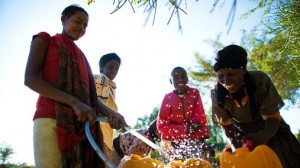Water Conservation
Important new technologies and initiatives are emerging every day helping attain safe, clean water for impoverished areas of the world.
Important new technologies and initiatives are emerging every day helping attain safe, clean water for impoverished areas of the world.
Many of us never stop to think about how fortunate we are to have access to clean water in our homes. There are so many parts of the world that rarely see clean water. Even if they’re lucky to have a natural source of water nearby, it’s often tainted with pollution, sewage or so filled with dirt that it’s more mud than water. According to UNICEF, over 884 million people are without safe drinking water. But there are new technologies and initiatives emerging every day to get safe, clean water to impoverished areas of the world.
 There are far more problems with dirty water than not being able to take a hot shower. Our bodies are composed mostly of water, and when the water we take in to replenish ourselves is loaded with bacteria and viruses, it causes serious health problems. Diarrhea caused by contaminated water results in 1.8 million deaths a year, with the majority of them in children under 5 years old.
There are far more problems with dirty water than not being able to take a hot shower. Our bodies are composed mostly of water, and when the water we take in to replenish ourselves is loaded with bacteria and viruses, it causes serious health problems. Diarrhea caused by contaminated water results in 1.8 million deaths a year, with the majority of them in children under 5 years old.
Cholera is another disease spread through polluted water. This bacterial infection of the intestinal tract leads to severe bouts of diarrhea that quickly cause dehydration and death. Exposure to arsenic in drinking water can lead to arsenicosis, which causes hard lesions to form on the skin and cancer to form in various internal organs. The list of problems that can arise from unsafe drinking water is long, and getting longer as we discover more bacteria and viruses that live in dirty water.
What’s both sad and inspiring is that the majority of the countries that are struggling to provide clean drinking water for their people have clean groundwater underneath them, but do not have wells to access that water. Wells in Africa have traditionally been dug by hand, but initiatives like The Water Project provide tools and help dig wells in parts of Africa that have no access to water. These tools include specific rigs that can dig through dirt and rock down roughly 200 feet to reach the groundwater. They also have the capability to dig wells over 900 feet deep, which provide significant amounts of water.
The Hope Project in South Africa has taken the idea of a traditional water filter and simplified it for individual use. These small filters – which are designed like tea bags – use carbon and other nanofibers to filter water. The system is remarkably simple: Fill a bottle with dirty water, drop-in a filter and drink the water. These simple tea bag filters cost about half a penny each and can successfully filter one liter of water before they need to be replaced.
Another promising development is the LifeStraw. The LifeStraw was designed by a Swiss company to help the absolute poorest of those who need clean drinking water. The device comes in both personal versions and versions designed for the family. Like its name implies, the personal version looks like a large, thick drinking straw, and one can filter roughly 1,000 liters. The family version can purify up to 18,000 liters, enough to keep a family hydrated for nearly three years. Most LifeStraws are currently being given away through aid groups, and the personal version recently entered the market in North America for consumer use. The LifeStraw removes contaminants as effectively as any other filter on the market as well as boiling water.
The next time you pour yourself a glass of cold water or take a hot bath, take a moment to appreciate what a valuable resource fresh, clean water is.
—
This is a guest post by Cassandra Lynne. Cassandra is the admin for Good Morning Bloggers and likes to blog about green living and fitness. Follow her on Twitter @goodmorningblog.